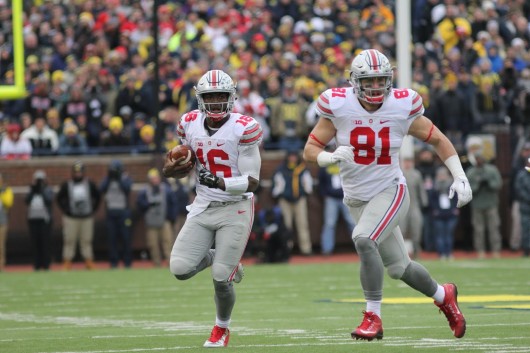
OSU redshirt sophomore J.T. Barrett (16) carries the ball while redshirt senior tight end Nick Vannett (81) looks for a defender to block during a game against Michigan on Nov. 28. OSU won, 42-13. Credit: Samantha Hollinshead | Photo Editor
For most of the season, the Ohio State offense seemed to have a flat tire. It was moving forward, but something was present that hampered it from rolling at its expected pace.
Then, against Michigan State last week, the wheels fell off.
The offense sputtered to just 132 yards in a puncturing loss, leaving behind a storm cloud of questions about what was vitiating a unit with so much talent.
Amid the aftermath, OSU coach Urban Meyer seemed to stumble upon a solution.
It had nothing to do with someone wearing shoulder pads or a helmet. Rather, it lied with those wearing headsets.
The fix? Moving offensive coordinator and offensive line coach Ed Warinner from the sideline up to the coaches box for a better vantage point in calling plays.
It might be a small sample size, but judging off Saturday’s 42-13 shellacking of 10th-ranked Michigan, it worked.
“He did a marvelous job,” Meyer said of Warinner. “We had to make the move … On Tuesday, I just said, ‘We’re going to do this.’”
The decision to alter Warinner’s gameday location might appear to be past due after the offense’s struggles throughout parts of the year, but there are reasons for its late arrival.
It is Warinner’s first season with the title “offensive coordinator” in front of his name after former offensive coordinator and quarterback coach Tom Herman left Columbus for a head-coaching job at Houston. Tim Beck was brought in from Nebraska to coach quarterbacks and be co-offensive coordinator.
For much of the early going, Beck, Warinner and Meyer all collaborated through the headsets on gameday about play-calling, with Beck being upstairs.
With the loss of a key coach, especially one of Herman’s abilities, growing pains should be present as the coaches settle on gameday roles. For the defending national champions, it just so happened that the growth took some time.
The other main reason, Meyer said, was because of Warinner’s job as the offensive line coach.
“To coach all five guys, and call a game, to be involved in the play calling — that’s tough,” Meyer said. “It’s difficult. You can only do that with a veteran offensive line.”
Fortunately for the Buckeyes, a veteran offensive line is exactly what they have. Four of the five starters were on the O-line that engineered massive holes down the stretch en route to winning the title. The only new starter — right tackle Chase Ferris — happens to be a fifth-year senior.
Without having its position coach on the sideline, concerns over how the offensive line is to deal with in-game adjustments are valid. It just took hitting rock bottom against the Spartans for the coaching staff to confront those concerns.
To fill his void during the game, Warinner said tight end coach Tim Hinton traded the warmth of the coaches box for a spot on the sideline. In addition, they also relied heavily on graduate assistant and former NFL offensive lineman Jim Cordle and senior center Jacoby Boren.
Warinner was heavy in his praise for Cordle and Boren, noting that he communicated with Boren a few times over the headset when he had comments or concerns.
“Jacoby understands what everybody does,” Warinner said. “I knew that if something was going on that we needed to make adjustments, that we could just call him and he would understand.”
Since a way to address all the concerns had been concocted, it allowed Warinner to go upstairs, where play calling becomes easier because of increased vision of the field. With that addition, it allowed the Buckeyes to play up-tempo for sustained periods of time.
“Part of playing fast is, ‘What’s the next call? Is it second-and-10, or second-and-5?’” Warinner said. “The situations, you see them. You don’t have to wait for someone to tell you. You just see it all and go.”
With its new set of wheels and a reduced operation time, the offense sure did go, racking up 482 yards, 369 of which came on the ground. At one point, it scored touchdowns on five of six possessions. The up-tempo scheme worked, as the Michigan defense became notably fatigued as the game worn on.
“You saw what happened when he went up there and called the plays today,” senior left tackle Taylor Decker said. “He’s a very capable coach and that criticism he was taking was unwarranted … The game plan wasn’t very complicated. It was very simple but it was high execution.”
Warinner said he was “real comfortable” up in the coaches box, noting that during early stops in his career, he called plays from upstairs. He also said the transition to working alongside Beck during the game was “very smooth.”
Because of the offense’s success against the Wolverines, there is reason to believe Warinner will remain upstairs for whatever postseason play comes the Buckeyes’ way. But the coach was quick to deny it was a permanent.
He instead tried to deflect attention off his migration to the coaches box to the players and their performance.
“It’s real gratifying for our team, our players, for the whole program when you win this game,” Warinner said. “It’s all about that, it’s not about me or do I feel better. Sure, I feel better because we won. Anything after that is fine but, it’s for the kids.”


